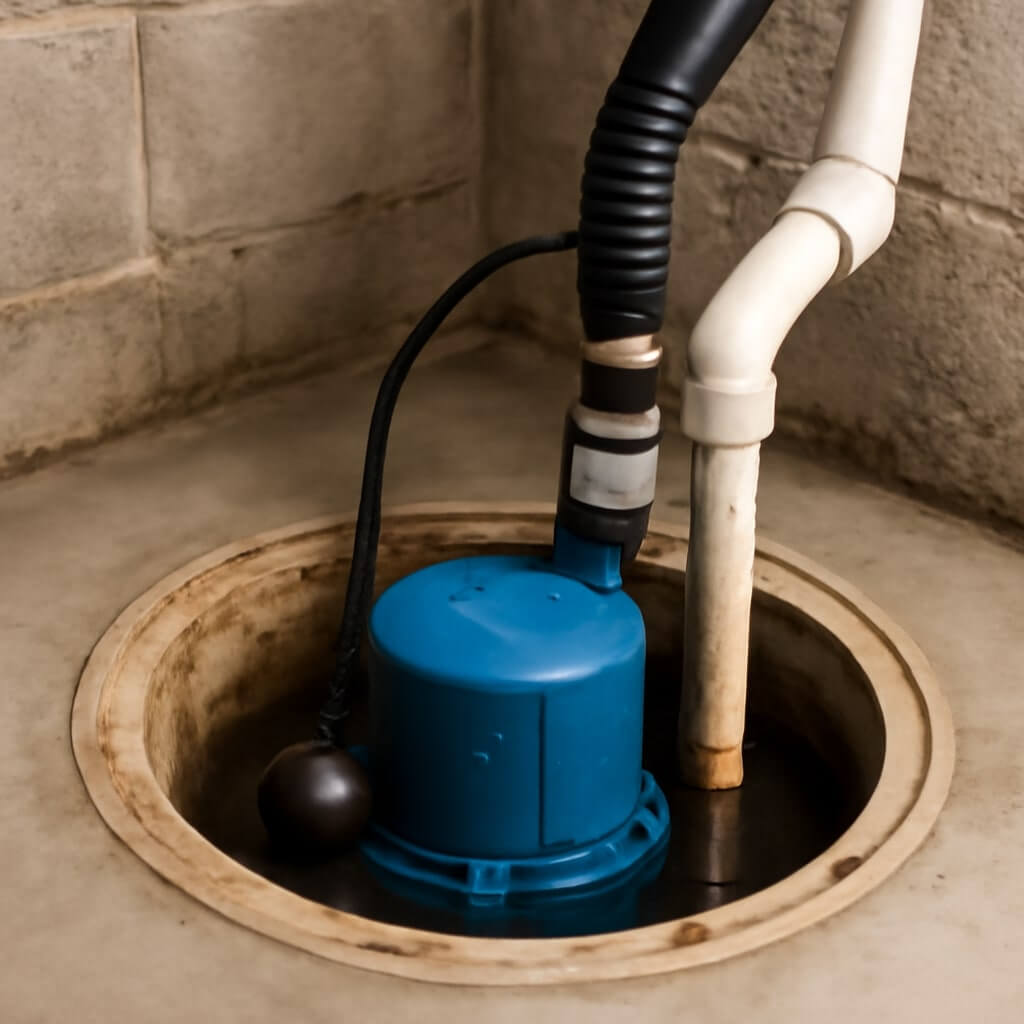A sump pump plays an essential role in basement waterproofing by actively removing excess water, which helps prevent flooding and moisture buildup. When water levels rise, the pump automatically activates, directing water away from your foundation. This process not only protects your property from potential damage but also enhances its overall value. Understanding how sump pumps operate and their various types can further illuminate their importance in maintaining a dry basement environment.
Key Takeaways
- Sump pumps actively remove excess water from basements, preventing flooding and water damage.
- They integrate with drainage systems, directing water away from the home’s foundation.
- By maintaining a dry environment, they significantly reduce the risk of mold growth.
- Sump pumps can lower flood insurance premiums, showcasing proactive water damage prevention.
- Their installation enhances property value, making homes more marketable and attractive to buyers.
Understanding the Basics of Sump Pumps
When you’re dealing with basement waterproofing, understanding sump pumps is essential.
Sump pumps are submersible devices designed to remove excess water from your basement, preventing flooding and moisture issues. The basic operation involves a float switch that activates the pump when water levels rise, directing water away from your home.
Familiarizing yourself with sump pump basics helps you choose the right model for your waterproofing solutions. Consider factors like pump capacity, power source, and maintenance requirements.
The Role of a Sump Pump in Flood Prevention
A sump pump plays an essential role in flood prevention for your basement. It actively removes excess water, preventing it from pooling and causing damage.
By integrating with your drainage systems, the pump efficiently directs water away from your foundation. This not only helps maintain a dry environment but also reduces the risk of mold and structural issues, which can impact your home’s value.
Integrating with drainage systems, a sump pump directs water away from your foundation, preserving your home’s value and preventing mold.
Additionally, having a reliable sump pump can lower your flood insurance premiums, as insurers recognize proactive measures against water damage.
Investing in a sump pump is a vital step in safeguarding your basement from flooding.
How Sump Pumps Operate
Sump pumps typically operate using a straightforward mechanism that efficiently removes water from your basement.
Understanding sump pump mechanics is essential for effective water removal. Here’s how they function:
- Float Switch Activation: When water levels rise, a float switch activates the pump.
- Water Discharge: The pump forces water through a discharge pipe, directing it away from your home.
- Automatic Operation: Many sump pumps feature automatic settings, ensuring they only run when necessary, conserving energy and prolonging lifespan.
Types of Sump Pumps and Their Functions
When choosing a sump pump, you’ll encounter various types, each designed for specific functions.
Pedestal sump pumps are ideal for applications with limited space, while submersible sump pumps are submerged in water for more efficient operation.
Additionally, battery backup systems guarantee your pump continues to function during power outages, providing extra protection against flooding.
Pedestal Sump Pumps
Pedestal sump pumps are a popular choice for homeowners looking to manage groundwater and prevent flooding in basements. Their pedestal design elevates the pump above the sump pit, making maintenance easier and allowing for improved airflow to the motor.
The installation process is straightforward, often requiring minimal tools and time.
Key features include:
- Height Advantage: Keeps the motor above potential water levels.
- Accessibility: Easier to service and replace components.
- Cost-Effective: Generally lower in price compared to submersible options.
Choosing a pedestal sump pump can provide effective basement waterproofing while simplifying maintenance tasks.
Submersible Sump Pumps
For homeowners facing persistent moisture issues, submersible sump pumps offer an efficient solution by operating underwater within the sump pit. These pumps come with several advantages, including reduced noise and improved efficiency. When considering submersible pump installation, it is crucial to evaluate their capabilities against your specific needs.
| Feature | Description |
|---|---|
| Design | Operates submerged in water |
| Noise Level | Quieter than pedestal pumps |
| Efficiency | Higher energy efficiency |
| Maintenance | Requires less frequent upkeep |
| Lifespan | Typically lasts longer |
Battery Backup Systems
A reliable battery backup system is essential for guaranteeing that your sump pump continues to operate during power outages or pump failures.
These systems provide peace of mind, especially in storm-prone areas. Here’s what to take into account:
- Battery life: Choose systems with long-lasting batteries to guarantee functionality during extended outages.
- Automatic activation: Look for backup systems that automatically engage when the primary pump fails or loses power.
- Maintenance: Regularly check battery health and connections to maintain peak performance.
Investing in a quality battery backup system can safeguard your basement against flooding, even when you’re not home.
Benefits of Installing a Sump Pump
Installing a sump pump offers critical advantages for your basement.
It prevents flooding, considerably reducing the risk of water damage and mold growth.
Additionally, a sump pump can enhance your property’s value by maintaining a dry and healthy environment.
Prevents Basement Flooding
Since basement flooding can cause significant damage to your property and lead to costly repairs, having a sump pump is essential for preventing such issues.
A sump pump actively removes excess water, ensuring your basement remains dry and protected. This flood prevention system works efficiently to minimize water damage by:
- Detecting rising water levels and activating promptly
- Discharging water away from your foundation
- Providing peace of mind during heavy rainfall or snowmelt
Reduces Mold Growth
When you install a sump pump, you greatly reduce the risk of mold growth in your basement.
By actively removing excess water, a sump pump creates a drier environment that inhibits mold spores from thriving. This mold prevention not only protects your belongings but also enhances indoor air quality.
Mold can release harmful spores into the air, which may lead to health issues. With a sump pump in place, you’re taking a proactive step in maintaining a safe, healthy living space.
Regular operation guarantees moisture levels stay low, further minimizing the potential for mold and its associated problems.
Enhances Property Value
A sump pump not only prevents mold growth but also greatly enhances your property’s value.
When considering home resale or property appraisal, a sump pump can make a significant difference. Buyers prefer homes with reliable waterproofing systems, as they reduce the risk of water damage.
Installing a sump pump can lead to:
- Increased marketability for your home
- Higher potential resale prices
- Positive appraisal outcomes due to reduced risk factors
Investing in a sump pump not only protects your basement but also positions your property as a more attractive option for potential buyers, ultimately boosting its value in the real estate market.
Maintenance Tips for Sump Pumps
Although sump pumps are designed to work reliably, regular maintenance is essential to guarantee peak performance and longevity.
Start with sump pump cleaning; remove debris and sediment from the basin and check the inlet screen for clogs.
Next, perform sump pump testing at least once a year. Pour water into the basin to confirm the pump activates and discharges water effectively.
Additionally, inspect the discharge pipe for blockages, and verify the float switch operates freely.
Finally, consider a backup power source, especially in areas prone to power outages.
Following these steps will keep your sump pump functioning at its best.
When to Consider Sump Pump Installation
Have you noticed recurring water issues in your basement or crawl space? It might be time to contemplate sump pump installation. This solution is vital if you experience:
- Frequent flooding or pooling water
- High humidity levels leading to mold growth
- Water stains or damage on walls and flooring
Understanding sump pump costs and installation timelines is important for budgeting. Typically, installation can take just a few hours, depending on your space’s complexity.
Addressing these concerns promptly can safeguard your home, making it a wise investment in basement waterproofing. Don’t wait until the problem escalates—act now for a dry and safe environment.
Conclusion
In summary, a sump pump is essential for effective basement waterproofing. By actively managing excess water, it safeguards your home against flooding and moisture-related issues. Installing a sump pump not only enhances your property’s value but also minimizes the risk of costly water damage. Regular maintenance guarantees peak performance, allowing you to enjoy a dry, safe basement. If you’re experiencing moisture problems or live in a flood-prone area, it’s time to contemplate adding a sump pump to your home.

